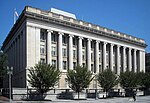United States Department of the Treasury

The Department of the Treasury (USDT) is the national treasury and finance department of the federal government of the United States where it serves as an executive department. The department oversees the Bureau of Engraving and Printing, and the U.S. Mint; these two agencies are responsible for printing all paper currency and coins, while the treasury executes its circulation in the domestic fiscal system. The USDT collects all federal taxes through the Internal Revenue Service; manages U.S. government debt instruments; licenses and supervises banks and thrift institutions; and advises the legislative and executive branches on matters of fiscal policy. The department is administered by the secretary of the treasury, who is a member of the Cabinet. The treasurer of the United States has limited statutory duties, but advises the Secretary on various matters such as coinage and currency production. Signatures of both officials appear on all Federal Reserve notes.Established by an Act of Congress in 1789 to manage government revenue, the first secretary of the treasury was Alexander Hamilton, sworn into office on September 11. Hamilton was appointed by President George Washington on the recommendation of Robert Morris, Washington's first choice for the position, who had declined the appointment. Hamilton established the nation's early financial system and for several years was a major presence in Washington's administration. The office is thus customarily referred to as "Treasury", solely, without any preceding article, as a remnant of the country's transition from British to American English during the late 18th century. Hamilton's portrait appears on the obverse of the ten-dollar bill, while the Treasury Department building is depicted on the reverse. The current secretary of the treasury is Janet Yellen, who was confirmed by the United States Senate on January 25, 2021. Jovita Carranza, appointed on April 28, 2017, was the incumbent treasurer, until January 15, 2020, when she left the office.
Excerpt from the Wikipedia article United States Department of the Treasury (License: CC BY-SA 3.0, Authors, Images).United States Department of the Treasury
Pennsylvania Avenue Northwest, Washington
Geographical coordinates (GPS) Address External links Nearby Places Show on map
Geographical coordinates (GPS)
| Latitude | Longitude |
|---|---|
| N 38.898333333333 ° | E -77.034166666667 ° |
Address
United States Department of the Treasury
Pennsylvania Avenue Northwest 1500
20006 Washington
District of Columbia, United States
Open on Google Maps










